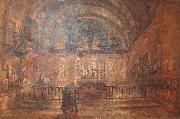China al por mayor de Marco de Oleo |
|||||||||||

|
|||||||||||
|
|
|
||||||||||||||
|
Wyke Bayliss
(October 21, 1835, Madeley, Shropshire - April 5, 1906, London) was a British painter, author and poet. He almost exclusively painted interiors of British and European churches and cathedrals, and was known in the late Victorian era as an academic authority on art. From the start of his career Bayliss' main interest was in depicting architecture, finding "infinite charm" in the "infinite variety of the aspect of a Cathedral interior". His unusual first name was his mother Anne's maiden surname. His brother William Wyke Bayliss became a vicar and sister Elizabeth Anne Bayliss married a vicar, whilst a second sister Mary died as a teenager. Bayliss' wider family consisted of a number of luminaries. His great uncle was Thomas Turner, founder of the Caughley porcelain factory, a major leader in the development of the Willow pattern. Bayliss owned a portrait of Turner by Sir Joshua Reynolds as well as a number of further family portraits by Lemuel Francis Abbott . His second cousin was Sir William Maddock Bayliss. Cologne Cathedral, pen and watercolourHis father, Rev. John Cox Bayliss was a railway engineer who taught military and mathematical drawing, and was also an artist known for his work "Views of Shropshire" published in 1839 . He gave his younger son training after he showed drawing aptitude at an early age. The family moved from Madeley to London following a job offer too good to refuse, giving Bayliss the opportunity to immerse himself in the emerging art scene of the early Victorian period. As a young student at the Royal Academy and the School of Design he became affiliated with the Pre-Raphaelites, and he counted amongst his friends John Millais, Frederic Leighton, William Holman Hunt and Edward Burne-Jones While distant from the Pre-Raphaelites in subject and technique, his paintings often reflect the juxtaposition of detail and colour that characterise much of Millais' and Leighton's work. Frederick Wedmore states in the foreword to Bayliss' autobiography "On reflection it will be seen that Wyke Bayliss had his speciality pretty well to himself. He was the inventor of his own genre - as well as his own method" . Bayliss paintings are held in many smaller UK and European collections, including the Atkinson Art Gallery in Southport (Evening: Amiens Cathedral) and the Welsh national collection. |
||||||||||||||
|
|
||||||||||||||
|
||||||||||||||
|
|
||||||||||||||
| Wyke Bayliss
(October 21, 1835, Madeley, Shropshire - April 5, 1906, London) was a British painter, author and poet. He almost exclusively painted interiors of British and European churches and cathedrals, and was known in the late Victorian era as an academic authority on art. From the start of his career Bayliss' main interest was in depicting architecture, finding "infinite charm" in the "infinite variety of the aspect of a Cathedral interior". His unusual first name was his mother Anne's maiden surname. His brother William Wyke Bayliss became a vicar and sister Elizabeth Anne Bayliss married a vicar, whilst a second sister Mary died as a teenager. Bayliss' wider family consisted of a number of luminaries. His great uncle was Thomas Turner, founder of the Caughley porcelain factory, a major leader in the development of the Willow pattern. Bayliss owned a portrait of Turner by Sir Joshua Reynolds as well as a number of further family portraits by Lemuel Francis Abbott . His second cousin was Sir William Maddock Bayliss. Cologne Cathedral, pen and watercolourHis father, Rev. John Cox Bayliss was a railway engineer who taught military and mathematical drawing, and was also an artist known for his work "Views of Shropshire" published in 1839 . He gave his younger son training after he showed drawing aptitude at an early age. The family moved from Madeley to London following a job offer too good to refuse, giving Bayliss the opportunity to immerse himself in the emerging art scene of the early Victorian period. As a young student at the Royal Academy and the School of Design he became affiliated with the Pre-Raphaelites, and he counted amongst his friends John Millais, Frederic Leighton, William Holman Hunt and Edward Burne-Jones While distant from the Pre-Raphaelites in subject and technique, his paintings often reflect the juxtaposition of detail and colour that characterise much of Millais' and Leighton's work. Frederick Wedmore states in the foreword to Bayliss' autobiography "On reflection it will be seen that Wyke Bayliss had his speciality pretty well to himself. He was the inventor of his own genre - as well as his own method" . Bayliss paintings are held in many smaller UK and European collections, including the Atkinson Art Gallery in Southport (Evening: Amiens Cathedral) and the Welsh national collection. Notre Dame Chapel, Barre-y-va, Caudebec-en-Caux, oil on canvas. This maritime chapel near the Seine is famous for its roof shaped as an upturned boat hull. |
||||||||||||||
|
Related Paintings to Wyke Bayliss :. |
||||||||||||||
|
|
||||||||||||||
|
|
||||||||||||||
|
CONTACTE EEUU |







